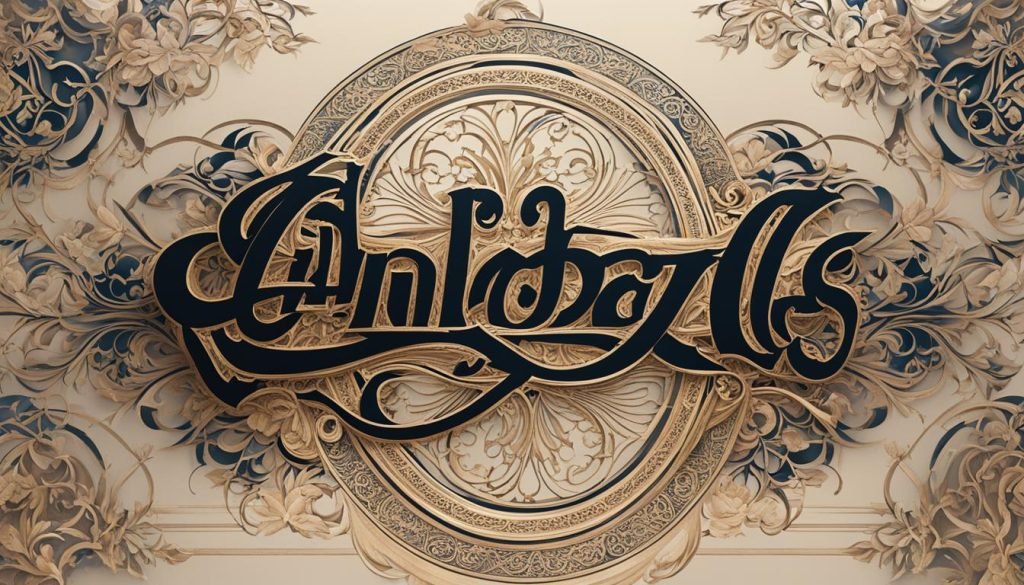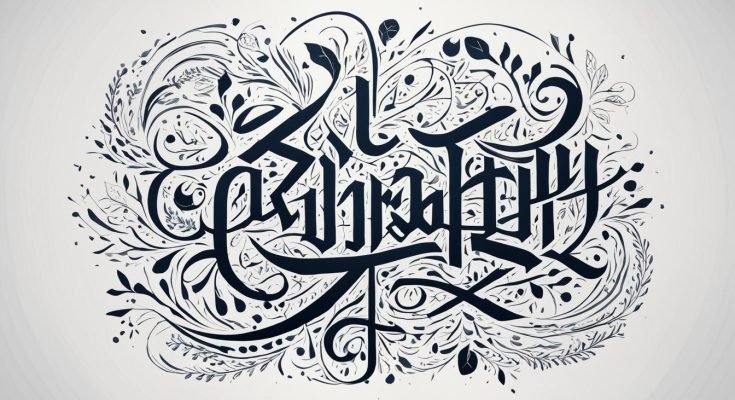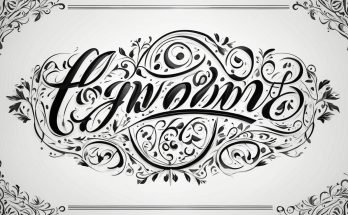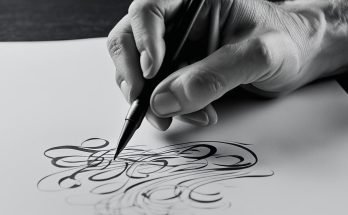Calligraphy Layout and Composition: Transform Your Pages into Works of Art
Creating beautiful calligraphy layouts that captivate the viewer requires careful consideration of design elements and composition techniques. Whether you’re a professional calligrapher or just starting out, understanding the principles of calligraphy layout and composition is essential to make your pages visually appealing and harmonious.
When it comes to calligraphy layout, there are several factors to consider. This includes line breaks, direction, curvature, shape, space, color, lettering style, and proportion. Each of these elements contributes to the overall composition and balance of your calligraphy designs. By experimenting with different combinations, you can unleash your creativity and create stunning pieces of art.
Key Takeaways:
- Understanding the elements of design is crucial for creating visually appealing calligraphy layouts.
- Experiment with line breaks, direction, shape, space, color, lettering style, and proportion to achieve balance and harmony.
- Draft your calligraphy layout in pencil first to plan dimensions and placement.
- Adequate margins and negative space guide the viewer’s eye and create a sense of balance.
- Practice and attention to layout can greatly improve your calligraphy designs.
What Is Calligraphy Layout And Composition?

Calligraphy layout refers to the process of turning your calligraphy practice into a beautiful finished piece of art. It involves deliberate choices and design principles to create a visually pleasing composition. The elements of design, including line, shape, space, color, lettering style, and proportion, all play essential roles in calligraphy layout and composition. Understanding and implementing these design elements can greatly enhance the overall quality and impact of your calligraphy designs.
When you approach calligraphy layout and composition, you are not just arranging words on a page but creating a harmonious visual experience. Each element contributes to the overall aesthetics of the piece, from the flow of the lines to the balance of negative space. By mastering these design principles, you can elevate your calligraphy to a whole new level.
Line is the fundamental building block of calligraphy. It determines the direction and flow of your composition, guiding the viewer’s eye across the page. The shape of your letters and their arrangement also play a critical role in calligraphy layout. Curvature, symmetry, and the overall form of your composition contribute to its visual impact.
“Calligraphy layout and composition is like a dance where each line, shape, and color complements and supports the others. It’s about creating a beautiful symphony of letters and design elements.”
Space is another crucial consideration in calligraphy layout. How you handle the empty parts of your page can greatly influence the overall composition. Negative space can create emphasis, provide breathing room, or establish a sense of balance. Intentional use of color can also enhance your calligraphy layout, adding vibrancy, contrast, and visual interest.
Lettering style is another element that adds depth and variety to your calligraphy composition. Experimenting with different calligraphy styles, scripts, and letterforms can offer fresh perspectives and creative possibilities for your layouts.
Lastly, proportion and balance are key principles of calligraphy layout and composition. By ensuring your letters and design elements are harmoniously sized and arranged, you can create a sense of equilibrium and visual appeal. Paying attention to proportion will help your composition feel cohesive and visually balanced.
Why Is Calligraphy Layout And Composition Important?
Mastering calligraphy layout and composition is crucial in creating visually stunning and captivating pieces of calligraphic art. A well-composed layout sets the structure and provides support to your calligraphy, making it easier to read, understand, and appreciate. Adequate margins and the use of negative space guide the viewer’s eye and create a sense of balance. Implementing the principles of design and making intentional choices in your calligraphy layouts can result in compositions that not only communicate your message but also invite viewers to spend time with your work.
Next, we will explore the different elements of design in calligraphy layout. Understanding each element and how they interact will help you create more effective and visually appealing compositions for your calligraphy designs.
The Elements Of Design in Calligraphy Layout

When it comes to creating visually stunning calligraphy layouts, understanding the key elements of design is essential. Incorporating these elements into your compositions can help you create balanced and aesthetically pleasing designs. In calligraphy and lettering, the elements of design that play a significant role include:
- Line: Line refers to the connections and breaks within your design. It determines the flow and movement of your composition, creating visual interest and guiding the viewer’s eye.
- Shape: Shape considers the overall form of your calligraphy layout. It involves the arrangement and arrangement of letters and characters, adding structure and coherence to your design.
- Space: Space involves how you handle the empty parts of your page. It includes considering the proportions of positive (occupied) space and negative (blank) space, allowing for a harmonious composition.
- Color: Color allows you to add emphasis and contrast to your calligraphy layout. It can be used to highlight specific letters or words, creating visual hierarchy and adding depth to your composition.
- Lettering Style: Lettering style gives you the freedom to explore different calligraphy styles and scripts. It allows you to experiment with various letterforms, adding creativity and uniqueness to your design.
- Proportion: Proportion adds emphasis and balance to your calligraphy layout. It involves considering the size and scale of your letters and characters, ensuring visual harmony and readability in your composition.
“By understanding and incorporating these elements of design into your calligraphy layout, you can create visually compelling compositions that captivate and engage your audience.”
Experimenting with the elements of design can lead to innovative and captivating calligraphy layouts. Let’s explore some practical tips and techniques for drafting and designing your calligraphy layout in the next section.
Elements of Design in Calligraphy Layout
| Element | Description |
|---|---|
| Line | The connections and breaks within your design, determining the flow and movement of your composition. |
| Shape | The overall form and arrangement of letters and characters in your calligraphy layout. |
| Space | The handling of positive and negative space, ensuring a harmonious composition. |
| Color | The use of color to add emphasis and contrast to your calligraphy layout. |
| Lettering Style | The exploration of different calligraphy styles and scripts to add creativity to your design. |
| Proportion | The consideration of size and scale to achieve balance and harmony in your composition. |
Tips for Drafting and Designing Calligraphy Layout

When it comes to calligraphy layout and composition, planning is key. By sketching your layout in pencil first, you can effectively plan the dimensions and placement of your calligraphy. This step allows you to experiment with different ideas and make adjustments before committing to ink.
As you draft your calligraphy layout, consider incorporating the following tips:
- Varying Weights: Experiment with different pen or brush sizes to create visual interest in your composition. Mixing thin and thick strokes can add depth and dimension to your calligraphy.
- Layering: Explore layering techniques by adding shadows or highlights to your letterforms. This technique can enhance the three-dimensional quality of your composition.
- Adding Borders or Decorative Elements: Incorporate borders or decorative elements that complement your calligraphy style. These additions can frame your composition and give it a polished look.
- Experimenting with Different Techniques: Don’t be afraid to explore different calligraphy techniques, such as brush lettering, pointed pen, or Gothic styles. Embracing various techniques can help you discover unique layouts and compositions.
To create a visually appealing composition, it’s essential to surround your layout with margins. Margins provide visual support to the text, ensuring that it stands out and is easily readable. Additionally, finding the optical center of your composition can create balance and guide the viewer’s eye.
To give you a visual example, here is a composition that effectively incorporates these tips:
By incorporating these tips and techniques, you can enhance the overall aesthetic of your calligraphy and create captivating compositions that grab the viewer’s attention.
The Importance of Careful Calligraphy Layout
Careful calligraphy layout plays a crucial role in creating visually appealing and engaging pieces of art. When you pay attention to the layout, it sets the structure and provides support to your calligraphy, making it easier for viewers to read and understand.
One key aspect of calligraphy layout is the use of adequate margins. Margins help frame your composition and create a sense of balance. They also guide the viewer’s eye, ensuring a smooth reading experience. By leaving enough space around your calligraphy, you give it room to breathe and make it visually appealing.
“The margins are like the white space in a painting. They create harmony and allow the eyes to rest, enhancing the overall aesthetic of your calligraphy.” – Emily Thompson
In addition to margins, negative space is another essential element in calligraphy layout. Negative space refers to the empty areas surrounding your calligraphy. By strategically incorporating negative space, you can create contrast, draw attention to key elements, and emphasize the beauty of your letterforms.
When working on calligraphy layout, it is essential to consider the principles of design. This includes elements such as line breaks, shape, proportion, and lettering style. By carefully considering these elements and making intentional choices, you can create compositions that captivate viewers and invite them to spend time with your work.
Remember, calligraphy layout is not just about aesthetics; it also influences readability and comprehension. By ensuring a well-balanced and visually pleasing layout, you enhance the overall impact of your calligraphy and create a more enjoyable experience for the viewer.
Tips for Careful Calligraphy Layout:
- Avoid overcrowding your composition by leaving enough space between lines and words.
- Experiment with different line breaks to create visual interest and guide the reader’s eye.
- Consider the overall shape of your composition and how it interacts with the space around it.
- Find inspiration from other calligraphers’ layouts and adapt them to suit your own style and purpose.
- Utilize the optical center of your composition to create balance and harmony.
By focusing on careful calligraphy layout, you can take your designs to the next level and create visually stunning pages that captivate and inspire.
Conclusion
Creating visually stunning calligraphy pages requires careful attention to calligraphy layout and composition. By understanding the elements of design and implementing them in your calligraphy layouts, you can achieve balanced and harmonious compositions.
Experiment with different techniques and tools to discover unique calligraphy design tips and composition techniques. Don’t be afraid to step out of your comfort zone and explore new ideas for calligraphy layout ideas and artistic calligraphy composition.
Remember to follow calligraphy composition rules and principles, such as considering line breaks, direction, curvature, shape, space, color, lettering style, and proportion. By practicing and refining your calligraphy layouts, you can improve your skills and create beautiful pieces of art that inspire and captivate viewers.
So go ahead, let your creativity flow and design stunning calligraphy pages that leave a lasting impression. With perseverance and dedication, you can master the art of calligraphy layout and composition and create breathtaking works of calligraphic art.
FAQ
What is calligraphy layout and composition?
Calligraphy layout refers to the process of turning calligraphy practice into a finished piece of art. It involves making intentional choices to create a visually pleasing composition.
What are the elements of design in calligraphy layout?
The elements of design that apply to calligraphy and lettering include line, shape, space, color, lettering style, and proportion.
How can I draft and design a calligraphy layout?
When drafting a calligraphy layout, it is important to sketch your layout in pencil first. Consider factors such as varying weights, layering, adding borders or decorative elements, and experimenting with different techniques.
Why is careful calligraphy layout important?
Careful calligraphy layout is important for creating visually appealing and engaging pieces of art. The layout sets the structure and provides support to your calligraphy, making it easier to read and understand.




